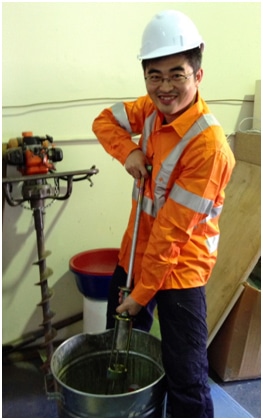Soil Compaction Testing Services

One of the services which ADE offers within our NATA accredited testing facility is soil compaction testing. This is achieved by comparing the compaction and moisture ratios obtained in the field with maximum values held by our in-house laboratory. In order to deliver this, ADE consultants conduct supervision onsite whilst compaction is undertaken to ensure proper procedures are performed.
We are accredited to perform:
- Nuclear Density Testing (On-site field density) [AS1289.5.8.1 / RMS T173]
- Standard Compactive Effort (Standard Proctor/Standard Compaction) [AS1289.5.1.1 / RMS T111]
- Modified Compactive Effort (Modified Proctor/Modified Compaction) [AS1289.5.2.1 / RMS T112]
When fill material is not sufficiently compacted, differential or uneven settlement may occur within the structure resting on this material. Compaction is therefore important as it removes air voids from within the material, enabling the material to compress slightly thereby avoiding settlement. If significant amounts of air voids remain within a material that has not been properly compacted, over time the structure will expunge the air voids from the soil, leading to settlement.
Nuclear Density Testing
Nuclear Density Testing is used to determine the field density and moisture content of compacted fill or in-situ soil. These tests are conducted using a portable nuclear gauge for which ADE consultants have attended an Australian Nuclear Science and Technology Organisation (ANSTO) course to ensure its safe operation and transportation. ADE has developed a set of Safe Work Method Statements (SWMSs) for the transportation and use of the gauges, along with company policies in the event of any incident(s) related to the nuclear density gauges.
In order to provide a reading, the field values are compared to values obtained from other tests which we have conducted to generate a relative compaction (compaction ratio) or relative moisture (moisture content ratio) to determine if the present rate of compaction satisfies appropriate values. A geotechnical engineer will sign off to ensure that the determined values are appropriate. As a general principle, the material needs to be 95% to 98% of maximum dry density.
All Nuclear Density tests are performed in regards to Australian Standard AS1289.5.8.1 or RMS T173 Method.
Standard Compactive Effort
Compaction TestingStandard Proctor testing is used to determine the maximum dry density and optimal moisture content when a standard compactive effort is applied. This test is generally used when compaction is applied on smaller areas (eg. trenches) using light weight compaction equipment such as compaction plates or wackers (hand compaction tool).
The Standard Proctor Test is conducted within the laboratory and involves using a standardised amount of energy to compact the material into moulds. In so doing, an optimal moisture content and maximum dry density for the material (based on standardised equipment) can be found. This maximum dry density and optimal moisture content are then compared with the values from the field testing (Nuclear Density Testing) to give a relative compaction, or compaction ratio.
These tests are performed in regards to Australian Standard AS1289.5.1.1 or RMS T111 Method.
Modified Compactive Effort
Modified Proctor testing is used to determine the optimum compaction and moisture when a modified compactive effort is applied. This test is generally used when compaction is applied on larger areas (eg. swabs or turnouts) using heavy compaction equipment such as vibration or smooth drum rollers in the field.
The test is similar to standard compaction, but a modified compactive effort is imparted to remould the specimen instead. Thus, the only difference is with regards to the amount of energy used to compact the material.
This test is performed to Australian Standard AS1289.5.2.1 and RMS T112 Method.


